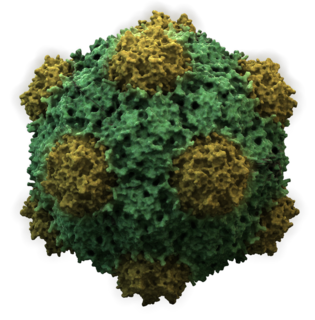
Comovirinae is a subfamily of viruses in the order Picornavirales, in the family Secoviridae; its genera were formerly classified in the family Comoviridae. Plants serve as natural hosts. There are 62 species in this subfamily, assigned to 3 genera.

Dicistroviridae is a family of viruses in the order Picornavirales. Invertebrates, including aphids, leafhoppers, flies, bees, ants, and silkworms, serve as natural hosts. There are 15 species in this family, assigned to three genera. Diseases associated with this family include: DCV: increased reproductive potential. extremely pathogenic when injected with high associated mortality. CrPV: paralysis and death.
Sequivirus is a genus of viruses in the order Picornavirales, in the family Secoviridae. Plants serve as natural hosts. There are three species in this genus. Diseases associated with this genus include: PYFV: vein-yellowing, yellow flecks and yellow/green mosaic symptoms in parsnip, and ‘yellow net', followed by yellow spots and leaf distortion in celery.
Teschovirus is a genus of viruses in the order Picornavirales, in the family Picornaviridae. Pigs serve as natural hosts. There are two species in this genus, including Teschovirus A, which is responsible for the porcine enteroviral encephalomyelitis disease caused in pigs. The genus name comes from this species and the disease it causes: Teschen disease, which itself was named for the town Teschen in Poland/Czechoslovakia where the disease was first recognised in 1929.
Aquamavirus is a genus of viruses in the order Picornavirales, in the family Picornaviridae. Seals serve as natural hosts. Only one species is in this genus: Aquamavirus A.
Avihepatovirus is a genus of viruses in the order Picornavirales, in the family Picornaviridae. Ducks and geese serve as natural hosts. There is only one species in this genus: Avihepatovirus A. Diseases associated with this genus include: fatal hepatitis.
Avisivirus is a genus of viruses in the order Picornavirales, in the family Picornaviridae. Turkey serve as natural hosts. There are three species in this genus.
Cosavirus is a genus of viruses in the order Picornavirales, in the family Picornaviridae. Human serve as natural hosts. There are 5 species in this genus.
Dicipivirus is a genus of viruses in the order Picornavirales, in the family Picornaviridae. Dog serve as natural hosts. There are two species in this genus.
Gallivirus is a genus of viruses in the order Picornavirales, in the family Picornaviridae. Turkey and chicken serve as natural hosts. There is only one species in this genus: Gallivirus A.
Hunnivirus is a genus of viruses in the order Picornavirales, in the family Picornaviridae. Cattle serve as natural hosts. There is only one species in this genus: Hunnivirus A.
Labyrnavirus is a monotypic genus of viruses in the order Picornavirales. Protist and labyrinthulomycetes serve as natural hosts, notably Aurantiochytrium. There is only one species in this genus: Aurantiochytrium single-stranded RNA virus 01.
Megrivirus is a genus of viruses in the order Picornavirales, in the family Picornaviridae. Turkey serve as natural hosts. There are five species in this genus. Diseases associated with this genus include: hepatitis.
Mischivirus is a genus of viruses in the order Picornavirales, in the family Picornaviridae. Bats serve as natural hosts. There are five species in this genus.
Mosavirus is a genus of viruses in the order Picornavirales, in the family Picornaviridae. Canyon mouse serve as natural hosts. There are two species in this genus.
Oscivirus is a genus of viruses in the order Picornavirales, in the family Picornaviridae. Birds serve as natural hosts. There is only one species in this genus: Oscivirus A.
Pasivirus is a genus of viruses in the order Picornavirales, in the family Picornaviridae. Pigs serve as natural hosts. There is only one species in this genus: Pasivirus A.
Rosavirus is a genus of viruses in the order Picornavirales, in the family Picornaviridae. Human and rodents serve as natural hosts. There are three species in this genus.
Salivirus is a genus of viruses in the order Picornavirales, in the family Picornaviridae. Human and chimpanzee serve as natural hosts. There is only one species in this genus: Salivirus A. Diseases associated with this genus include: probably gastroenteritis.
Sapelovirus is a genus of viruses in the order Picornavirales, in the family Picornaviridae. Pig serve as natural hosts. There are two species in this genus.

